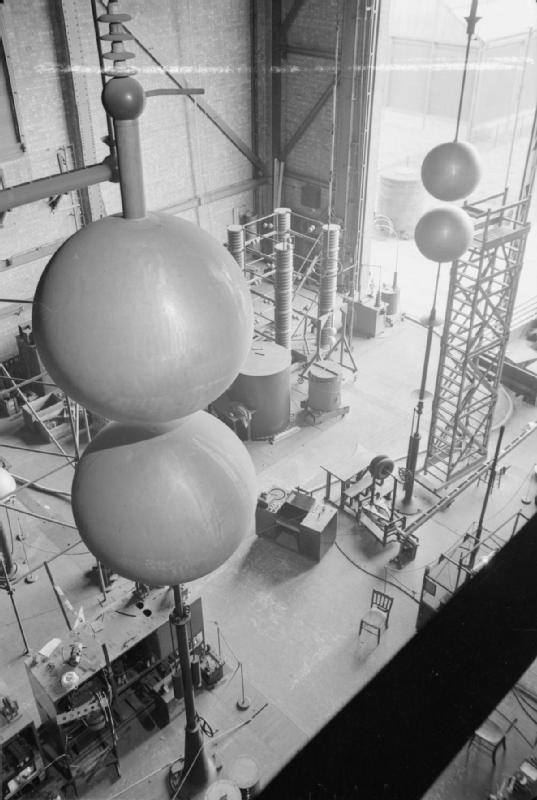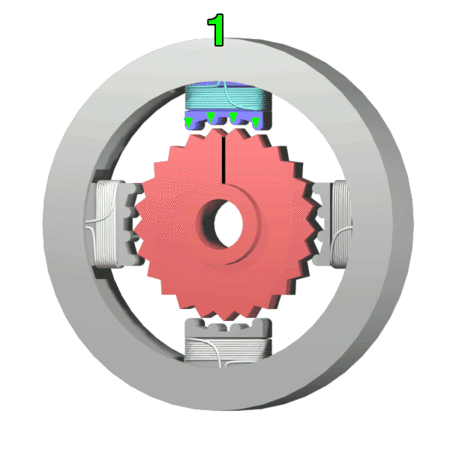|
Time-of-flight Ultrasonic Determination Of 3D Elastic Constants
The three-dimensional elastic constants of materials can be measured using the ultrasonic immersion method. This was pioneered by Zimmer and Cost from the National Physical Laboratory in the 1960s. It has mainly been used for polymer composite materials. Knowledge of the elastic constants can be used to feed back into models of the material's behaviour or that of the composite manufacturing process used. Immersion technique The ultrasonic immersion method makes use of a temperature stabilised water bath which has a pair of ultrasonic transducers located on either side of the sample which can be rotated using a stepper motor. The time of flight of an ultrasonic pulse that has been transmitted through the material is measured using an electronic timer that determines the start of the transmitted pulse and the start of the received pulse using threshold detection. This timer is typically accurate to microsecond A microsecond is a unit of time in the International System of Uni ... [...More Info...] [...Related Items...] OR: [Wikipedia] [Google] [Baidu] |
Ultrasound
Ultrasound is sound waves with frequency, frequencies higher than the upper audible limit of human hearing range, hearing. Ultrasound is not different from "normal" (audible) sound in its physical properties, except that humans cannot hear it. This limit varies from person to person and is approximately 20 Hertz, kilohertz (20,000 hertz) in healthy young adults. Ultrasound devices operate with frequencies from 20 kHz up to several gigahertz. Ultrasound is used in many different fields. Ultrasonic devices are used to detect objects and measure distances. Ultrasound imaging or sonography is often used in medicine. In the nondestructive testing of products and structures, ultrasound is used to detect invisible flaws. Industrially, ultrasound is used for cleaning, mixing, and accelerating chemical processes. Animals such as bats and porpoises use ultrasound for locating Predation, prey and obstacles. History Acoustics, the science of sound, starts as far back as Pyth ... [...More Info...] [...Related Items...] OR: [Wikipedia] [Google] [Baidu] |
National Physical Laboratory (United Kingdom)
The National Physical Laboratory (NPL) is the national measurement standards laboratory of the United Kingdom. It is one of the most extensive government laboratories in the UK and has a prestigious reputation for its role in setting and maintaining physical standards for British industry. Founded in 1900, it is one of the oldest metrology institutes in the world. Research and development work at NPL has contributed to the advancement of many disciplines of science, including the development early computers in the late 1940s and 1950s, construction of the first accurate atomic clock in 1955, and the invention and pioneering implementation of packet switching in the 1960s, which is today one of the fundamental technologies of the Internet. The former heads of NPL include many individuals who were pillars of the British scientific establishment. NPL is based at Bushy Park in Teddington, west London. It is under the management of the Department for Business, Energy and Industrial ... [...More Info...] [...Related Items...] OR: [Wikipedia] [Google] [Baidu] |
Polymer
A polymer (; Greek '' poly-'', "many" + ''-mer'', "part") is a substance or material consisting of very large molecules called macromolecules, composed of many repeating subunits. Due to their broad spectrum of properties, both synthetic and natural polymers play essential and ubiquitous roles in everyday life. Polymers range from familiar synthetic plastics such as polystyrene to natural biopolymers such as DNA and proteins that are fundamental to biological structure and function. Polymers, both natural and synthetic, are created via polymerization of many small molecules, known as monomers. Their consequently large molecular mass, relative to small molecule compounds, produces unique physical properties including toughness, high elasticity, viscoelasticity, and a tendency to form amorphous and semicrystalline structures rather than crystals. The term "polymer" derives from the Greek word πολύς (''polus'', meaning "many, much") and μέρος (''meros'' ... [...More Info...] [...Related Items...] OR: [Wikipedia] [Google] [Baidu] |
Composite Material
A composite material (also called a composition material or shortened to composite, which is the common name) is a material which is produced from two or more constituent materials. These constituent materials have notably dissimilar chemical or physical properties and are merged to create a material with properties unlike the individual elements. Within the finished structure, the individual elements remain separate and distinct, distinguishing composites from mixtures and solid solutions. Typical engineered composite materials include: *Reinforced concrete and masonry *Composite wood such as plywood *Reinforced plastics, such as fibre-reinforced polymer or fiberglass *Ceramic matrix composites ( composite ceramic and metal matrices) *Metal matrix composites *and other advanced composite materials There are various reasons where new material can be favoured. Typical examples include materials which are less expensive, lighter, stronger or more durable when compared with commo ... [...More Info...] [...Related Items...] OR: [Wikipedia] [Google] [Baidu] |
Heated Bath
A heated bath is used in the laboratory to allow a chemical reaction to occur at an elevated temperature. The heated bath is a fluid placed in an open (metal) pot. Water and silicone oil are the most commonly used fluids. A water bath is used for temperatures up to 100 °C. An oil bath is employed for temperatures over 100 °C. The heated bath is heated on a hot plate, or with a Bunsen burner. The reaction chamber (Florence flask, Erlenmeyer flask, or beaker) is immersed in the heated bath. A thermometer is usually kept in the fluid to monitor the temperature. See also *Bain-marie, a.k.a. double boiler *Heat bath *Laboratory water bath – maintains a constant temperature, for extended time, under a cover *Sand bath A sand bath is a common piece of laboratory equipment made from a container filled with heated sand. It is used to evenly heat another container, most often during a chemical reaction. A sand bath is most commonly used in conjunction with a hot ... {{Chem-st ... [...More Info...] [...Related Items...] OR: [Wikipedia] [Google] [Baidu] |
Transducers
A transducer is a device that converts energy from one form to another. Usually a transducer converts a signal in one form of energy to a signal in another. Transducers are often employed at the boundaries of automation, measurement, and control systems, where electrical signals are converted to and from other physical quantities (energy, force, torque, light, motion, position, etc.). The process of converting one form of energy to another is known as transduction. Types * Mechanical transducers, so-called as they convert physical quantities into mechanical outputs or vice versa; * Electrical transducers however convert physical quantities into electrical outputs or signals. Examples of these are: ** a thermocouple that changes temperature differences into a small voltage; ** a linear variable differential transformer (LVDT), used to measure displacement (position) changes by means of electrical signals. Sensors, actuators and transceivers Transducers can be categorized by whi ... [...More Info...] [...Related Items...] OR: [Wikipedia] [Google] [Baidu] |
Stepper Motor
A stepper motor, also known as step motor or stepping motor, is a brushless DC electric motor that divides a full rotation into a number of equal steps. The motor's position can be commanded to move and hold at one of these steps without any position sensor for feedback (an open-loop controller), as long as the motor is correctly sized to the application in respect to torque and speed. Switched reluctance motors are very large stepping motors with a reduced pole count, and generally are closed-loop commutated. Mechanism Brushed DC motors rotate continuously when DC voltage is applied to their terminals. The stepper motor is known for its property of converting a train of input pulses (typically square waves) into a precisely defined increment in the shaft’s rotational position. Each pulse rotates the shaft through a fixed angle. Stepper motors effectively have multiple "toothed" electromagnets arranged as a stator around a central rotor, a gear-shaped piece of iron. Th ... [...More Info...] [...Related Items...] OR: [Wikipedia] [Google] [Baidu] |
Pulse
In medicine, a pulse represents the tactile arterial palpation of the cardiac cycle (heartbeat) by trained fingertips. The pulse may be palpated in any place that allows an artery to be compressed near the surface of the body, such as at the neck ( carotid artery), wrist (radial artery), at the groin (femoral artery), behind the knee (popliteal artery), near the ankle joint (posterior tibial artery), and on foot (dorsalis pedis artery). Pulse (or the count of arterial pulse per minute) is equivalent to measuring the heart rate. The heart rate can also be measured by listening to the heart beat by auscultation, traditionally using a stethoscope and counting it for a minute. The radial pulse is commonly measured using three fingers. This has a reason: the finger closest to the heart is used to occlude the pulse pressure, the middle finger is used get a crude estimate of the blood pressure, and the finger most distal to the heart (usually the ring finger) is used to nullify the eff ... [...More Info...] [...Related Items...] OR: [Wikipedia] [Google] [Baidu] |
Microsecond
A microsecond is a unit of time in the International System of Units (SI) equal to one millionth (0.000001 or 10−6 or ) of a second. Its symbol is μs, sometimes simplified to us when Unicode is not available. A microsecond is equal to 1000 nanoseconds or of a millisecond. Because the next SI prefix is 1000 times larger, measurements of 10−5 and 10−4 seconds are typically expressed as tens or hundreds of microseconds. Examples * 1 microsecond (1 μs) – cycle time for frequency (1 MHz), the inverse unit. This corresponds to radio wavelength 300 m (AM medium wave band), as can be calculated by multiplying 1 μs by the speed of light (approximately ). * 1 microsecond – the length of time of a high-speed, commercial strobe light flash (see air-gap flash). * 1 microsecond – protein folding takes place on the order of microseconds. * 1.8 microseconds – the amount of time subtracted from the Earth's day as a result of the 2011 Japanese earthquake. * 2 m ... [...More Info...] [...Related Items...] OR: [Wikipedia] [Google] [Baidu] |
Elwin Bruno Christoffel
Elwin Bruno Christoffel (; 10 November 1829 – 15 March 1900) was a German mathematician and physicist. He introduced fundamental concepts of differential geometry, opening the way for the development of tensor calculus, which would later provide the mathematical basis for general relativity. Life Christoffel was born on 10 November 1829 in Montjoie (now Monschau) in Prussia in a family of cloth merchants. He was initially educated at home in languages and mathematics, then attended the Jesuit Gymnasium and the Friedrich-Wilhelms Gymnasium in Cologne. In 1850 he went to the University of Berlin, where he studied mathematics with Gustav Dirichlet (which had a strong influence over him) among others, as well as attending courses in physics and chemistry. He received his doctorate in Berlin in 1856 for a thesis on the motion of electricity in homogeneous bodies written under the supervision of Martin Ohm, Ernst Kummer and Heinrich Gustav Magnus. After receiving his doctorate, Ch ... [...More Info...] [...Related Items...] OR: [Wikipedia] [Google] [Baidu] |






